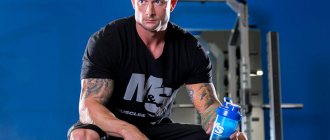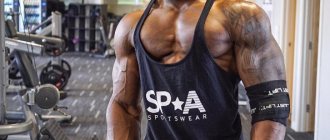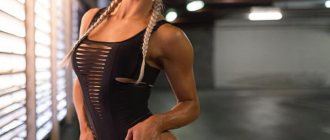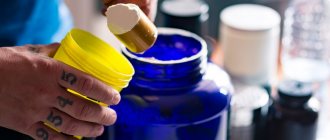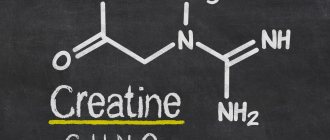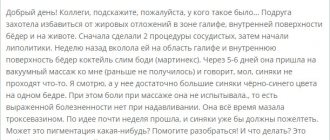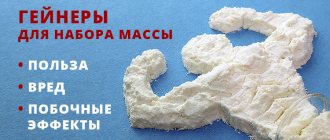Nitrogen-containing carboxylic acid is a natural substance that provides muscles with energy and strength, improves training performance. Creatine is found in food and is produced by internal organs on the basis of amino acids (the kidneys and pancreas are involved in the process). Due to its prevalence and safety, this substance has gained great popularity in bodybuilding and is widely used in sports nutrition.
In this article we will look at where creatine is found and whether an athlete can get the required portion of the substance from regular food. The following food tables will allow you to properly organize your diet.
We recommend reading: How to burn visceral fat
What it is?
Creatine is an important element for the body; it is essentially a nitrogen-containing carboxylic acid.
First of all, it is a source of energy. The main property of the substance is the saturation of cells with water molecules. Creatine is found in meat and fish, and is also partially synthesized from amino acids. According to experts, the daily requirement for an athlete is 2-4 g. Note that in order to get this amount of the substance with regular food, you need to eat at least 200 g of beef or other red meat per day, which is quite difficult. In addition, this will lead to additional stress on the internal organs, which will receive not pure energy, but a whole set of protein and fats. Therefore, creatine is recommended for absolutely all athletes, especially since it is easy to purchase and its prices are quite affordable. This sports supplement is especially popular among representatives of strength and speed disciplines. They noted significant increases in maximum bench weight, number of repetitions, and peak velocity over a short period.
In which animal products (table)
All types of red meat contain creatine, because... are an example of muscle tissue. It is in these fibers that acid actively accumulates. Diet foods contain slightly less of the substance, but can easily be used to fill the deficiency.
Note! Fatty sea fish with red meat contain a high percentage of acid. For example, salmon are significantly superior to flounder or river roach in this characteristic.
Chicken and goose eggs have virtually no creatine in their composition (about 20-30 mg per 1 kg of product). Whole cow's milk, cottage cheese and cheeses are more preferable in this regard.
Which animal products contain creatine compounds:
| Product | Content (g/kg) |
| Herring | 7 |
| Pork | 5 |
| Salmon | 5 |
| Chicken | 4,4 |
| Beef | 4 |
| Tuna | 4 |
| Turkey | 3,8 |
| Duck | 3,5 |
| Cod | 3 |
| Milk | 0,1 |
Animal dishes should form the basis of athletes' nutrition. Regular consumption of natural combinations of protein, amino acids and creatine will make it easier to endure physical activity and achieve noticeable athletic progress. However, it is worth considering the high calorie content of such products - if there is insufficient calorie consumption, the resulting substances can accumulate and contribute to excess weight.
An ideal option for creatine content would be carpaccio, ceviche or tartare made from high-quality fresh animal products. It is also acceptable to use gentle steaming.
Why do you need creatine?
It is this substance that helps us cope with pain and physical discomfort. In addition, the element helps strengthen joints and tendons and replenishes energy.
Creatine consumption has an effect on:
- Strength and endurance . During heavy training, the body primarily turns to this source of energy. In this way, ATP and glycogen are saved, which increases strength indicators and allows you to quickly move on to increasing the load. Greater efficiency is observed in the example of short-term sports indicators.
- Muscle volume . With constant intake of creatine, muscles increase in size and become round due to the accumulation of fluid in the cells. In this case, an increase occurs exclusively in dry mass, without fat.
- Rate of recovery and growth of muscle tissue . The element improves the quality of the muscle nutritional environment, thereby providing a supply of glycogen and building material.
- Vessels . The use of this substance helps reduce cholesterol levels, which prevents the occurrence of myocardial infarction and other vascular diseases.
- Heart . Creatine naturally regulates the correct rhythm of contractions.
The supplement helps avoid muscle breakdown during drying. For weight loss, it can be used to increase the intensity of training. Otherwise, it is useless for fat burning. Despite the fact that the effect of the substance is associated with the production of testosterone, women are not prohibited from using it, however, the result is not as good as in men. Creatine is a natural source of energy that is not a dope, and therefore is also used in team sports.
Creatine and other sports supplements
Creatine and waxy corn starch
Creatine interacts well with waxy corn starch, together they have a good effect on the body before and after workouts. The simple sugars contained in waxy corn promote good absorption of creatine, which allows athletes to give their best during training.
Creatine and carbohydrates with proteins
It has been scientifically proven that a substance in a one-to-one ratio with simple carbohydrates (dextrose) or proteins is the optimal combination for effective absorption by the body. In terms of effectiveness, this is equal to the effects of creatine and dextrose separately. For the best progress of the training process and recovery after it, a combination of creatine with waxy corn starch or protein powders for use before and after physical activity is excellent.
Creatine and pre-workout supplements
Most pre-workout supplements contain nitric oxide. The combination of creatine with it forms a very powerful mixture, which significantly increases the explosive energy of the athlete. Nitric oxide improves the mental and physical state of a person, which allows you to perform physical exercises with greater effort, and it also increases the effect of creatine, to which the body responds with increased muscle growth.
Creatine and supplements for use during training
Supplements designed to be taken during exercise typically include waxy maize starch, BCAA, vitamins and minerals. Some already contain creatine. The combination of such supplements with creatine makes a very specific sense, since the effect of the substance on the body occurs before and after training. Taking both types of supplements together will ensure faster delivery and absorption of creatine, preparing your muscles for growth and recovery.
Creatine and post-workout supplements
Most athletes take creatine post-workout supplements. They mainly already contain creatine, as well as waxy corn starch. There is nothing more to add here.
Creatine and fat burners
Creatine is a natural fat burner. It stimulates the growth of energy in the body, allows you to give more effort in training, therefore, more calories will be spent. Add fat burners and you will lose fat cells at a tremendous rate.
Is creatine dangerous?
Pregnancy is a contraindication to the use of the supplement. Children, asthmatics, allergy sufferers, diabetics and people with kidney failure should consult a doctor first. No side effects from consumption have been identified in the entire history of the drug. This is not surprising, since the substance itself is natural. As a rule, its excess is eliminated from the body without having a detrimental effect on internal organs. However, significantly exceeding the norm can cause a number of negative consequences, such as edema, dehydration, digestive disorders and cramps. All these manifestations are extremely rare and can be prevented immediately by stopping the drug. They may also be associated with the use of an expired product. The main conditions for comfortable use of the product: an active lifestyle or regular training, as well as drinking enough water. In addition, many supplements contain a number of other substances along with creatine, so you need to carefully study the composition of sports nutrition before purchasing and give preference to reliable brands.
A lack of creatine in the body threatens to slow down physical activity. In the absence of physical activity, the need for the substance may arise in vegetarians. Contrary to popular myths, taking the supplement does not affect reproductive function in any way.
Where is it contained?
To improve physical activity, increase overall endurance and strength, the human body needs to receive a sufficient amount of creatine. With regular strength training, an athlete needs from 1 to 5 grams of this substance per day. The specific dosage is calculated individually and depends on the weight category and sports goals.
You can ensure the supply of this substance using your usual diet or special sports supplements. If an athlete strives to get all the required portion from regular food, he needs to know which foods contain the most of this acid.
How to take it correctly
The daily dose is 3-5 grams. We are talking about creatine monohydrate, the most effective supplement with the highest content of this substance. It may be in the form of powder, tablets or capsules. This compound is also often found in pre-workout supplements, so if you use one of those, you may not need to purchase anything extra.
It is recommended to take creatine on an empty stomach, for example, immediately after training. When entering the body during the digestion of other food, the substance can be destroyed without fulfilling its final purpose. Caffeine-containing products can also neutralize the effect of the drug. On the days between workouts, eating every two hours, it is appropriate to drink a serving before one of your meals. Creatine dissolves well in warm water, juice, milk, and it is appropriate to add it to protein shakes.
An interesting feature of creatine is that it is better absorbed at elevated insulin levels, so it is advisable to use it with fast carbohydrates. And this is mainly sweet, which all people who watch their figure fear like fire. Honey and molasses can be used as a healthier substitute; in addition, many creatine products already contain glucose.
Iron and iron health: what role does the microelement play in our body?
Iron is part of hemoglobin. In turn, the protein hemoglobin is a building material for erythrocytes - red blood cells that carry oxygen from the lungs to the organs, and on the way back rid them of carbon dioxide. Actually, this process is called cellular respiration. Without iron it is impossible. And since every cell in our body needs oxygen, iron can be called one of the most important elements.
The synthesis of hemoglobin takes 60–70% of all iron entering the body. The remaining 30–40% is deposited in tissues and spent on solving other problems - metabolic processes, regulation of the thyroid gland, maintaining the body's defense system and connective tissue synthesis.
As you can see, the functions of iron are varied and numerous, but oxygen transport is the most important of them.
Iron is poorly absorbed even with ideal health and proper diet - the human body is able to absorb up to 10% of the iron supplied with food [1].
Daily iron requirement in healthy people
Iron requirements vary depending on age and health status.
Infants under six months of age have little need for iron, since they are born with a fair supply of this element. Newborns only need 0.27 mg of iron per day. Children from six months to a year require 11 mg, children from 1-3 years old - 7 mg, children aged 4-8 years - 10 mg, 9-13 years old - 8 mg.
Adolescents 14–18 years old should receive 11–15 mg daily, with girls having a higher need for iron due to monthly blood loss during menstruation.
Men require about 10 mg of iron per day, women - 15-18 mg. During pregnancy, the norm increases to 25–35 mg, and during breastfeeding - to 25 mg.
We recommend reading: Does nicotine affect muscle growth?
After approximately 50 years, the iron requirement for men and women becomes the same - about 10 mg per day [2].
These are average figures, but in some cases the need for iron may be slightly higher than the statistical average. Athletes and people engaged in heavy physical labor require more iron. The need for iron also increases during recovery from operations and injuries (especially if they were accompanied by blood loss), infectious diseases, as well as for those who suffer from constant bleeding (hemorrhoids, stomach ulcers, nosebleeds, heavy menstruation, etc.).
Foods High in Iron
Our body cannot synthesize iron; it only processes this element, extracting it from worn-out red blood cells. “Fresh” iron comes from food. However, even if you eat foods containing iron, this does not mean that you have enough. The thing is that there are two types of iron.
Iron can be heme (divalent) or non-heme (trivalent). The first is found in products of animal origin and is easily digestible (about 25%), the second is part of plants and is absorbed by only 8–10% maximum [3]. This is why vegans and vegetarians often lack this element, even if they eat foods rich in iron.
And yet, it is the right diet that is considered the main way to prevent iron deficiency. Iron is found in significant doses in the following foods:
Animal products:
- pork liver - 29 mg (hereinafter the figure is given per 100 g of product);
- hard cheese - 19 mg;
- beef liver - 9 mg;
- egg yolk - 6 mg;
- beef tongue - 5 mg;
- turkey - 4 mg;
- beef - 2.8 mg;
- chicken - 2.5 mg;
- mackerel - 2.5 mg;
- pork - 1.6 mg;
- herring - 1 mg;
- cottage cheese - 0.4 mg.
Products of plant origin:
- beans - 72 mg;
- hazelnuts - 51 mg;
- oat flakes - 45 mg;
- fresh forest mushrooms - 35 mg;
- millet - 31 mg;
- peas - 20 mg;
- seaweed - 16 mg;
- prunes - 13 mg;
- dried apricots - 12 mg;
- buckwheat - 8 mg;
- tofu - 5.5 mg;
- peaches - 4.1 mg [4].
Although the iron content of some plant foods is high, the non-heme form of iron is poorly absorbed. Therefore, it is important for those following a plant-based diet to check their iron levels and, if necessary, take dietary supplements that contain this element.
Our body perceives iron best from meat (on average 20% is absorbed), a little worse from fish and seafood (about 11%), legumes (7%) and nuts (6%). Only 1-3% of iron is absorbed from fruits, vegetables and cereals.
To improve the absorption of iron, it is also important to receive the right amounts of vitamins and minerals, which play the role of catalysts and help this element to be absorbed. These include:
We recommend reading: Exercises for hips at home
- Vitamin C. Iron is almost not absorbed without ascorbic acid, so the menu must include foods rich in ascorbic acid - berries, oranges and grapefruits, cabbage, red peppers.
- Vitamin A. If a person lacks vitamin A, then iron will not be absorbed and used to “build” new red blood cells. Many orange and yellow fruits and vegetables are rich in vitamin A - it is this substance that gives them their cheerful colors. To replenish vitamin A reserves, you need to eat more dried apricots, carrots and pumpkin. However, it's important to know that fats are needed for this vitamin to be absorbed, so don't ignore sources of retinol like butter, fish oil, and egg yolks.
- Folic acid (vitamin B9). It helps absorb iron and normalizes the digestive tract, and healthy digestion is extremely important for the absorption of this element. Sources of folic acid are eggs, soybeans, yeast, green leafy vegetables, dill, eggplant, tomatoes, chicken liver.
Pregnant women and women taking oral contraceptives have a particularly high need for folic acid.
- Copper. Sources of copper are offal, fish and seafood (shrimp, oysters, etc.), cabbage.
Rules for rational nutrition
The more variety of products you use in cooking, the less likely you are to become deficient in iron or any other trace element or vitamin. However, the diet for iron deficiency also contains some restrictions. The fact is that some elements can impair the absorption of this mineral. This does not mean that you need to completely abandon them. But it is better not to eat foods containing iron at the same time as:
- tea and coffee, red wine. These drinks reduce the body's ability to absorb iron by about a third, by the way, like chocolate;
- milk and dairy products. They are rich in calcium, and calcium is not friendly with iron;
- sesame and seeds, bran, sprouted wheat, nuts. All of these foods are valuable sources of magnesium. But magnesium, like calcium, interferes with the absorption of iron.
If your goal is to increase your blood iron levels, eat all of the above foods only 3-4 hours after foods high in iron. But you should avoid fatty and fried foods, ready-made oil sauces such as mayonnaise, hot spices and marinades - all this irritates the mucous membranes of the gastrointestinal tract and interferes with the absorption of iron.
An example of a daily diet: today is my “iron” day...
How to create a menu that will help cope with iron deficiency? It's actually not difficult. Foods rich in iron and the vitamins necessary for its absorption are neither rare nor particularly expensive. Here is an example of an “iron” diet for one day:
Breakfast : 2 soft-boiled eggs or scrambled eggs, fresh cabbage salad, a slice of black bread with butter and hard cheese, orange juice.
Second breakfast : curd mousse with dried apricots and prunes or oatmeal with dried fruits, rosehip infusion.
Lunch : chicken soup or borscht with mushrooms, stewed liver with onions or baked turkey with vegetable stew, fruit salad and dried fruit compote.
Calculate your ideal sports weight!
Dinner : steamed beef patties or mackerel baked in foil, pea puree or stewed carrots, soothing herbal tea.
This menu is not only rich in iron, vitamins C, B9 and copper, it also fits the definition of dietary, contains a sufficient amount of fiber and will not harm your figure.
Iron intake standards for patients with anemia
Sometimes tests reveal not just a lack of iron, but a more serious situation - iron deficiency anemia. Typically, this condition develops against the background of gastrointestinal diseases, tumor processes, helminthic infestations, and constant bleeding. It is often diagnosed in people who have experienced significant blood loss during injury or surgery.
Iron deficiency anemia is diagnosed if the hemoglobin level drops to 100–70 g/l and serum ferritin drops to 15 ng/ml.
If iron deficiency anemia is diagnosed, you cannot prescribe treatment yourself. The doctor selects the therapy. Perhaps he will prescribe multivitamin complexes and dietary supplements with iron, and in the most severe cases, he may even prescribe iron supplements - quite strong drugs with numerous side effects. You can take such medications only under the supervision of your doctor.
Rules for taking dietary supplements as additional sources of iron
“People may not always stick to a healthy diet or eat enough iron-rich foods,” says the expert. — In this case, dietary supplements enriched with iron can be a good help. But you shouldn’t think that they are all the same and any similar remedy will improve the situation in a week. Very often, people buy iron-containing dietary supplements without thinking about the dosage at all. And this is very important. Before taking dietary supplements, you need to consult your doctor and do a blood test that will show your iron levels. Based on this, the doctor will recommend a daily iron intake, and after that you can select a remedy.
Iron-containing dietary supplements are not only tablets and capsules. For example, our assortment includes “Ferrohematogen” - a sweet chewing bar based on iron-rich albumin. This is a good additional source of iron, and this “candy” is convenient to carry with you and use as a light snack. "Ferrohematogen" is enriched with vitamins C, B6 and B12, as well as copper - these supplements accelerate the absorption of iron."
How to choose creatine
Over time, the popularity of the supplement only increases. You can purchase it at any specialized store. If you decide to buy creatine, keep in mind that:
- The most effective are drugs from the USA and Germany;
- For beginners, tablets are better;
- The effectiveness of the product does not depend on the form of release of the supplement (bars, powder, capsules, etc.);
- The packaging usually contains instructions for use. If it is missing or written in a language unknown to you, contact the store consultants or trainer.
Creatine is a useful and quite potent supplement, so you need to approach its purchase and use responsibly. Proper use will allow you to achieve impressive results in a short time.

